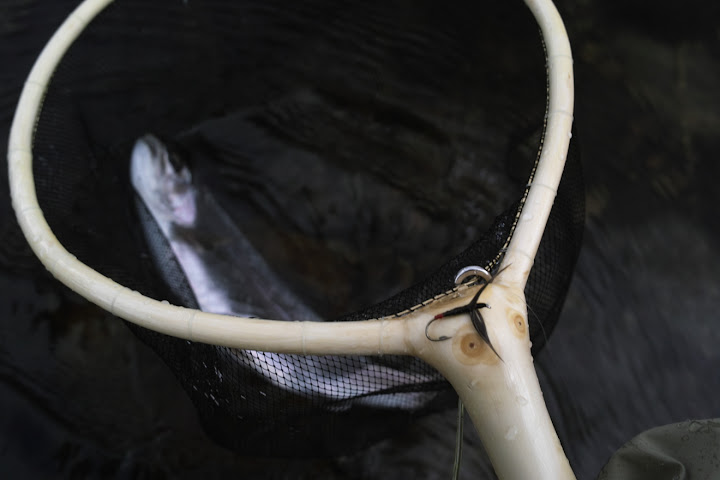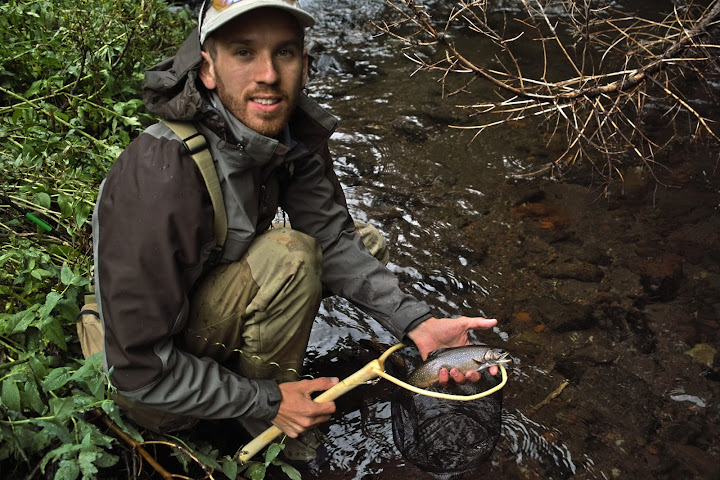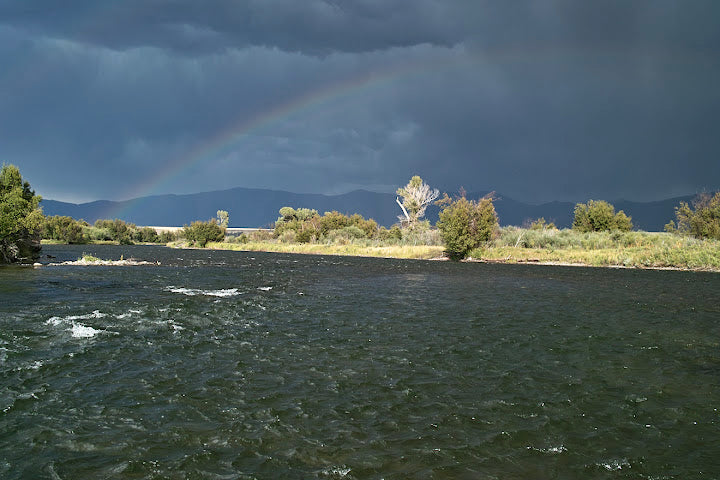
After the presentation I met with Bryan, a tenkara angler who lives in the area. He, a friend of his, his friend's son and I headed to the lower part of the Madison, near town. We fished for about an hour and nothing. The kid had a size 14 grasshopper on, I stuck with one tenkara fly. But we couldn't manage a bite, not on the hopper, nor on the tenkara fly. That's when confidence started seeping out - what is happening? Will they take a different fly? Is my presentation not good enough? In this case there was relatively heavy boat traffic where we were fishing, and I attributed our lack of activity to that. Or, that fact that perhaps I still hadn't figured out the right technique for such big water. We left the stream, and went our separate ways. As there were still a couple of hours of sunlight left, I wanted to do some more fishing for the rest of the day. There a few good mountain streams in the area, the type of water I really like. However, I just couldn't give up on the Madison. This would be one the few chances I'd have to say that "yes, you can also use any one fly in the Madison, or anywhere with running water and trout". If I want to master my tenkara technique I'd have to work hard for it. I returned to the exact same location and was greeted by this beautiful sun light and rainbow, a good sign perhaps.
This time I was a bit freer to move anywhere and a bit faster; so I worked that area very hard. I went upstream, across, downstream, to the middle, and to some very likely pools, hitting all spots that I knew should have fish in them. For an hour or so I only saw a flash or two. Then, confidence started seeping out again. I had a grasshopper and an elk-hair caddis in my box, two "just-in-case" flies I still haven't had the confidence to put away. I tied the large hopper on, this was the fly everyone in town has been raving about for the Madison. About 10 minutes with the hopper and nothing but one tiny strike. I then tied on the size 12 elk-hair caddis, fished it for about 5 minutes on a couple of very likely spots, still nothing. I paused for a moment and thought about what I could do differently to catch fish. First of all, I should stick with my one fly, if the results with these "just-in-case" flies are not that apparent, I think I can make it work with my tenkara fly. In reality any fly of reasonable size should work given the right presentation and manipulation.
How can I make this work? If I only had my tenkara fly, how could I catch fish with it?
This pause was probably sufficient. I had primarily been sticking with dead drifts: casting upstream or to the side and following the fly down with no drag. Sometimes I would cast to the side, pause the fly in place for a couple of seconds, let it go downstream (in a straight line, not swinging), and pause. And sometimes I would cast a bit downstream and work the fly upstream, and other times I'd just cast upstream and try to get the fly deep by lowering my rod tip and gradually lifting it to keep a tight line. Pretty much the major tenkara techniques, in a simplified explanation. One technique I hadn't been using, however, was giving the tenkara fly a lot of life by casting to the side and very abruptly pulling the fly towards me (with the line in the water). I did this vigorously, pulling at about 1ft intervals, a bit like a streamer. This worked! Suddenly I was getting into fish. The reasoning: the water was very fast in this area and the fish needed to really see the fly well, so giving it a lot of action was necessary. After a couple of fish I decided to switch to a bigger fly, a size 10 which "Tenkara Ouji" had sent me, to increase its visibility. This also worked very well, although I know I could have just as easily stuck with the same fly I had been using. I landed a few (maybe 4 or 5) 12 inchers, lost 2 fish about 16-17" when I was about to land them (yes, I'll be thinking about these in my sleep, and yes, the bigger ones are always the ones that get away!), and missed a few strikes, a couple of which were very good.

For many months now I have made a point to stick with one fly pattern only. My box has one fly pattern, mostly size 12, but in couple of different sizes and color combinations - all virtually the same. I would have no problem having only one identical fly, but I like having different ones so I can show different tenkara flies to people. I pick the fly at random, except if the water is very high and I know I want more visibility (both for myself and for the fish), in which case I like using a light colored or bigger fly. In the months since completely converting to one fly only, I have fished more often than I ever have (fishing about 10-15 days out of each month). And, I continue catching fish, and probably many more fish than I ever have too. I also initially met the theory of using one fly with great skepticism. It took me exactly a year to fully convert to using one fly pattern only. But, I have learned a lot about how to fish since then. I am striving for perfecting technique and simplifying my fly fishing, I'm now really learning how to fish. I have embarked on a quest to fully embrace fishing technique, and let go of the accepted current thought of "match-the-hatch". The longer I fish with only one fly, the more confident I become in my technique, and the fewer fish I catch "out of luck", or because they "like" a specific fly. Most fish I currently catch, I know why I caught them, and if I don't catch a fish I know I can improve my technique. The fly shouldn't be the major concern of the angler, professional fisherman in Japan made a living out of fishing with one fly pattern, how can we argue with that? In current western thought the emphasis has been on finding just the right fly, for the pool, for the weather, for that fish. We forget that perhaps we can do something differently with the same fly to catch fish. We try to make up for lack of technique with different flies. This theory, that one can use any one fly to catch fish based on his/her technique, will be met with skepticism - this was my own initial reaction to it - and it may be controversial, given that as anglers we have all had the experience of switching a fly and then hooking a fish, and that few people ever talk about this. I don't believe it is the norm among all anglers in Japan, but for what I see most of the more experience tenkara anglers in Japan use one fly and stick with it. I do see it as potentially a paradigm shift in our mentality for fly-fishing. That a whole group of anglers uses one fly and then focuses on technique is encouraging. I will also try stick with one fly and will focus on my technique. "Simple fly, simple fly", as the Tenkara Bum says. And so the "just-in-case" flies are now gone for good!
If you only had one fly pattern in your box, could you still catch fish? If you ran out of your "go-to" fly pattern, would you feel okay and continue fishing, or would your day be ruined?

